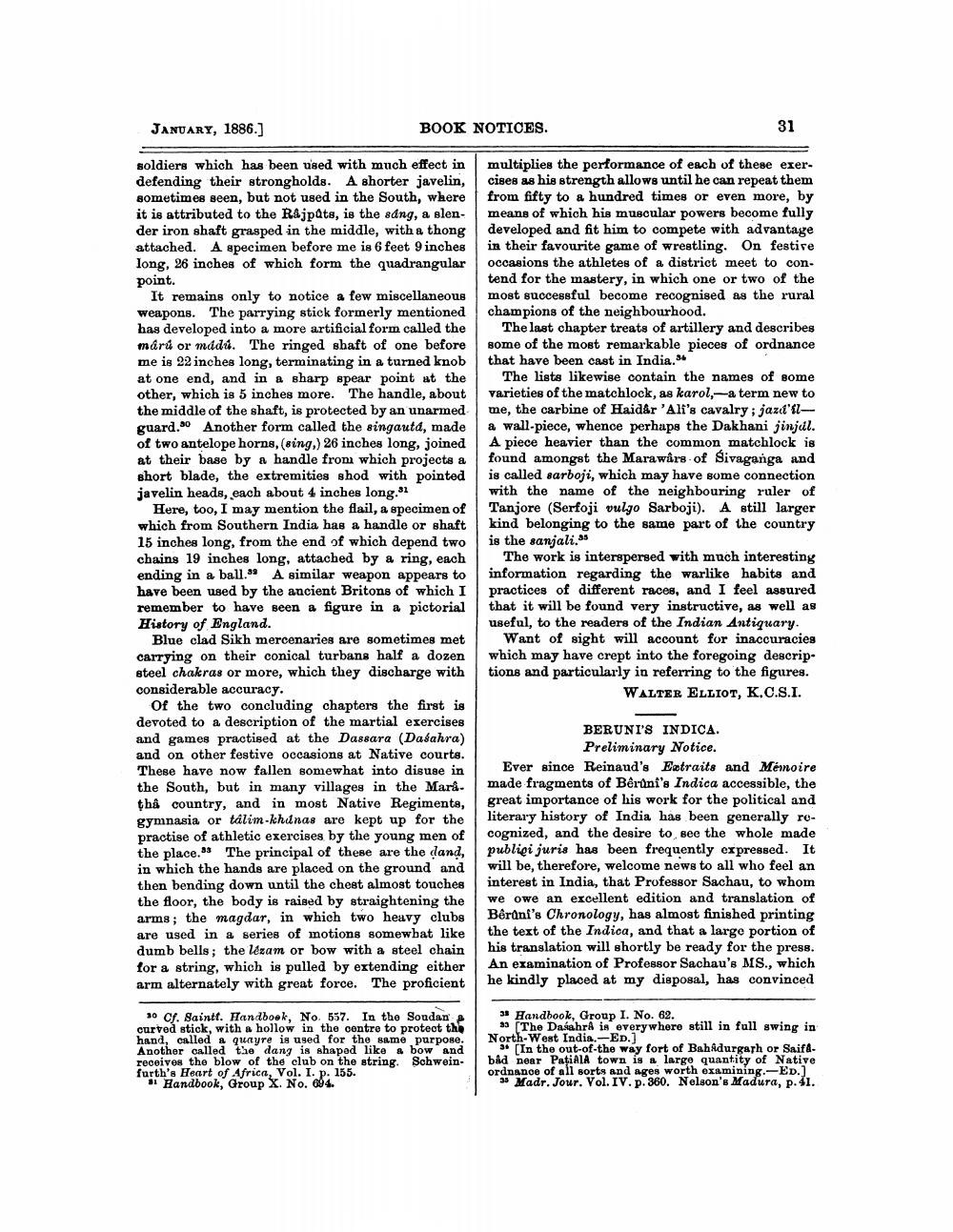________________
BOOK NOTICES.
JANUARY, 1886.]
soldiers which has been used with much effect in defending their strongholds. A shorter javelin, sometimes seen, but not used in the South, where it is attributed to the Rajputs, is the sáng, a slender iron shaft grasped in the middle, with a thong attached. A specimen before me is 6 feet 9 inches long, 26 inches of which form the quadrangular point.
It remains only to notice a few miscellaneous weapons. The parrying stick formerly mentioned has developed into a more artificial form called the márú or mádú. The ringed shaft of one before me is 22 inches long, terminating in a turned knob at one end, and in a sharp spear point at the other, which is 5 inches more. The handle, about the middle of the shaft, is protected by an unarmed guard.30 Another form called the singautá, made of two antelope horns, (sing,) 26 inches long, joined at their base by a handle from which projects a short blade, the extremities shod with pointed javelin heads, each about 4 inches long."
Here, too, I may mention the flail, a specimen of which from Southern India has a handle or shaft 15 inches long, from the end of which depend two chains 19 inches long, attached by a ring, each ending in a ball. A similar weapon appears to have been used by the ancient Britons of which I remember to have seen a figure in a pictorial History of England.
Blue clad Sikh mercenaries are sometimes met carrying on their conical turbans half a dozen steel chakras or more, which they discharge with considerable accuracy.
Of the two concluding chapters the first is devoted to a description of the martial exercises and games practised at the Dassara (Dasahra) and on other festive occasions at Native courts. These have now fallen somewhat into disuse in the South, but in many villages in the Marâthâ country, and in most Native Regiments, gymnasia or talim-khanas are kept up for the practise of athletic exercises by the young men of the place. The principal of these are the dand, in which the hands are placed on the ground and then bending down until the chest almost touches the floor, the body is raised by straightening the arms; the magdar, in which two heavy clubs are used in a series of motions somewhat like dumb bells; the lézam or bow with a steel chain for a string, which is pulled by extending either arm alternately with great force. The proficient
30 Cf. Saintt. Handboek, No. 557. In the Soudan curved stick, with a hollow in the centre to protect the hand, called a quayre is used for the same purpose. Another called the dang is shaped like a bow and receives the blow of the club on the string. Schweinfurth's Heart of Africa, Vol. I. p. 155.
1 Handbook, Group X. No. 694.
31
multiplies the performance of each of these exercises as his strength allows until he can repeat them from fifty to a hundred times or even more, by means of which his muscular powers become fully developed and fit him to compete with advantage in their favourite game of wrestling. On festive occasions the athletes of a district meet to contend for the mastery, in which one or two of the most successful become recognised as the rural champions of the neighbourhood.
The last chapter treats of artillery and describes some of the most remarkable pieces of ordnance that have been cast in India.
The lists likewise contain the names of some varieties of the matchlock, as karol,-a term new to me, the carbine of Haidar 'Ali's cavalry; jazd'ila wall-piece, whence perhaps the Dakhani jinjal. A piece heavier than the common matchlock is found amongst the Marawârs of Sivaganga and is called sarboji, which may have some connection with the name of the neighbouring ruler of Tanjore (Serfoji vulgo Sarboji). A still larger kind belonging to the same part of the country is the sanjali.35
The work is interspersed with much interesting information regarding the warlike habits and practices of different races, and I feel assured that it will be found very instructive, as well as useful, to the readers of the Indian Antiquary.
Want of sight will account for inaccuracies which may have crept into the foregoing descriptions and particularly in referring to the figures. WALTER ELLIOT, K. C.S.I.
BERUNI'S INDICA. Preliminary Notice.
Ever since Reinaud's Extraits and Mémoire made fragments of Bêrûnî's Indica accessible, the great importance of his work for the political and literary history of India has been generally recognized, and the desire to see the whole made publigi juris has been frequently expressed. It will be, therefore, welcome news to all who feel an interest in India, that Professor Sachau, to whom we owe an excellent edition and translation of Bêrani's Chronology, has almost finished printing the text of the Indica, and that a large portion of his translation will shortly be ready for the press. An examination of Professor Sachau's MS., which he kindly placed at my disposal, has convinced
3 Handbook, Group I. No. 62.
33 [The Dasahra is everywhere still in full swing in North-West India.-ED.]
3 [In the out-of-the way fort of Bahadurgarh or Saifbåd near PatiAlA town is a large quantity of Native ordnance of all sorts and ages worth examining.-ED.]
35 Madr. Jour. Vol. IV. p. 360. Nelson's Madura, p. 41.




